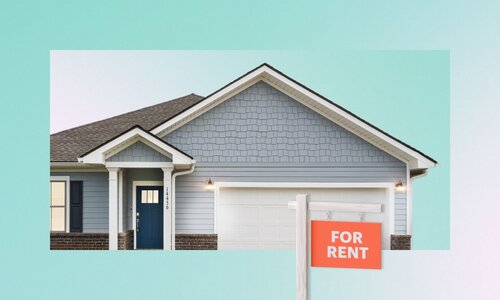One of the biggest hurdles to buying your first home is coming up with a down payment. If you find yourself in need of help getting the funds together, you may have options.
Down payment assistance is provided through government agencies or private organizations to help first-time homebuyers climb the property ladder. This assistance often includes grants and no-interest loan programs and can speed up and help you save toward your financial goals. Here’s what you need to know.
What is down payment assistance?
When you buy a new home, you may need to pay a certain percentage of the home’s final purchase price upfront, aka the down payment. Since this money can be challenging to put together for many people buying their first home, down payment assistance loans, programs, and grants are available to help first-time buyers.
Often this comes in the form of zero-interest loans or cash advances that typically only need to be repaid when the home is refinanced or sold. Other programs offer cash grants, which can be used for a specific purpose, such as a down payment.
How does down payment assistance work?
Down payment assistance programs benefit both the buyer and the community. Local governments are keen to support first-time homebuyers because when new buyers move into a neighborhood, they make home improvements, pay property taxes, and enable community development through the support of local stores and businesses.
Local U.S. economies benefit from homeownership, so it makes sense that local or state housing authorities, nonprofits, and organizations, such as the U.S. Department of Housing and Urban Development (HUD), would help make it possible for people to purchase homes and move into these communities.
While most DPA programs are administered by state and local governments, as well as through private entities, housing finance agencies, and charitable organizations, there are federal DPA problems as well. These include first-time homebuyer tax credits, cash grants, and interest rate subsidies. They can also come in the form of forgivable loans. All DPA programs will have their requirements, such as those available to people buying in specific neighborhoods or streets or particular professions, such as teachers, nurses, firefighters, and EMTs.
How much you can get will also depend on the individual program. While some DPAs offer a percentage of the home’s sales price, others will cap assistance at a particular dollar amount. When looking into programs, you’ll want to look carefully through their eligibility requirements and what is being offered.
Another thing to remember is that manyl DPA programs require you to get your mortgage loan from an approved lender or mortgage provider. DPA-approved mortgages can include:
- Fannie Mae and Freddie Mac loans
- FHA loans that the Federal Housing Administration backs
- VA loans, backed by Veterans Affairs
- USDA or U.S. Department of Agriculture-backed loans.
Who can qualify for down payment assistance?
Most programs will have strict requirements for qualification, and you may need to provide documentation to prove you don’t own any rental or investment properties.
These are some things DPA programs will look at as qualifying criteria:
- Credit score: A minimum credit score may be required for some programs.
- Household income limits: Many DPA programs are geared towards low- and moderate-income households; you’ll need to meet those income criteria to qualify.
- Location: Most DPA programs are available for home purchases in specific counties or locations.
- First-time homebuyer: The definition can vary between programs. For some programs, a first-time homebuyer is defined as someone who has not owned property in three years.
- Knowledge: You may be asked to take a homebuyer education course.
- Time: You may be required to live in the purchased house for a certain number of years. Typically, this is between 3 and 10 years.
- Debt-to-income ratio: Many programs will also consider your debt-to-income ratio or DTI when providing assistance.
- Approved mortgage program: You may be required to get your home loan from an approved mortgage lender.
Types of assistance
There are a number of ways to receive down payment assistance. Some ways in which it is offered include:
1. Cash grants
Cash grants are the most valuable and the most common type of down payment assistance available. What makes them enticing is that cash grants provide money that homeowners are not required to repay. The average first-time homebuyer cash grant award is around $10,000. You can also apply for closing cost credits through one-time cash grants providing closing cost assistance.
Since this is free money, it often comes with a few conditions, most of which the grantee puts in place to build community and encourage economic growth. You may, for instance, be required to keep the home as your primary residence for several years, failing which you’ll be required to repay the grant in part or full.
The Downpayment Toward Equity Act offers first-time buyers up to $25,000 in cash that can be used for down payment and closing costs.
2. Forgivable loans
Forgivable mortgage loans are 0% interest loans, basically second mortgages you don’t have to repay. This is conditional, however, on the borrower staying in the home for a certain number of years. You’ll want to read the terms and conditions carefully before signing up for a forgivable loan. If you move before the forgiveness period ends, you’ll be required to pay back all or part of the loan.
3. Deferred-payment loans and low-interest loans
Deferred-payment loans are often offered at 0% interest, but unlike forgivable loans, they must be repaid. The loan amount is usually large enough to cover a down payment and doesn’t have to be repaid until you move, sell, refinance your first mortgage, or pay down your first loan.
Low-interest loans are also available from many participating lenders to cover down payments. Again, while these fixed-rate loans have repayment terms, starting immediately, the interest rate is lower than your mortgage, allowing you to pay them off faster. That said, it’s important to remember that when you take out a low-interest loan in addition to your mortgage, you’re effectively making two monthly payments.
4. Matched savings programs
Matched savings programs will match the buyer’s deposit, which means that you can double what you’ve saved. Matched savings programs will require a homebuyer to deposit their own money into a bank, government agency, or community organization, after which the institution offering the DPA will add an equivalent amount into the account, which can then be used as the down payment.
If you’re not yet ready to purchase a home but want to start investing in real estate, we’ve got you covered. At Arrived, our mission is to give everyone — regardless of their background and income levels — the chance to get on the property ladder.
The opinions expressed in this article are for general informational purposes only and are not intended to provide specific advice or recommendations for any individual or on any specific security or investment product. The views reflected in the commentary are subject to change at any time without notice. View Arrived’s disclaimers.







